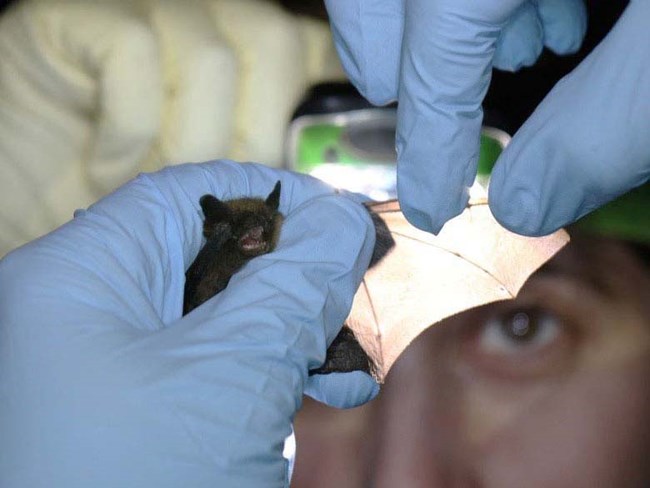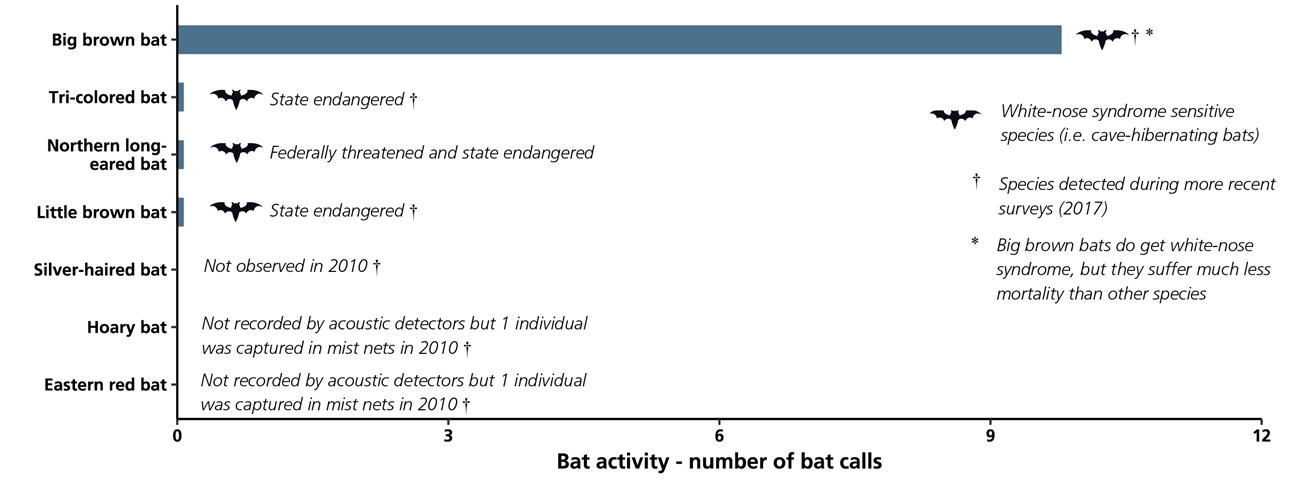Last updated: September 25, 2018
Article
Bat Population Monitoring at Saint-Gaudens National Historic Site

NPS photo.
Bats are an important part of ecosystems and food webs. Though some species of bats feed on fruit, seeds, or pollen, all of the species that live in the Northeast are insectivores. They consume huge numbers of insects every night, filling a unique ecosystem role as nocturnal insect predators. Unfortunately, a new disease called white-nose syndrome is affecting bats across the United States. To better protect bats, scientists are studying how local bat populations are changing.
Research Highlights
- Seven species of bats have been documented in the park, including the federally threatened northern long-eared bat.
- White-nose syndrome has reduced bat populations in Saint-Gaudens.
- Little brown bats and northern long-eared bats, once very common, are now rare.
- Big brown bats are the most common bat in the park. These bats are less sensitive to white-nose syndrome.
How do biologists study bats? What have they learned about bats in the park?
Biologists use a variety of techniques to study bats. Special nets (i.e. mist nets) can be used to catch bats at specific sites in the park. Captured bats can reveal important information about bats. Biologists can learn when females give birth to their pups (bat babies), the locations of “maternity roost” sites, and when and where bats are most vulnerable to disturbance. Biologists also can assess bat health and learn if the bat is infected with the fungus.Biologists have other creative ways of studying these unique animals. Bats use echolocation to navigate and catch insect prey during the dark of night. People can’t hear these bat calls, but biologists use special microphones, called acoustic detectors, to record the sounds. By analyzing the bat calls, biologists can identify which specific bat species are present in an area during certain times of the year.
In all, seven species of bats have been documented in the park. These include the federally threatened and state endangered northern long-eared bat (Myotis septentrionalis), the state endangered tri-colored bat (Perimyotis subflavus) and the state endangered little brown bat (Myotis lucifugus).
In 2010, acoustic detectors were used to measure bat activity levels in Saint-Gaudens (see Figure 1 below). Big brown bats (Eptesicus fuscus) were the most frequently recorded. Big brown bats are less sensitive to white-nose syndrome, possibly because of their body size or due to differences in the cave environments where this species prefers to hibernate.

In all, bat activity was the highest at Beaman Barn, Blow-Me-Down Farm, and Blow-Me-Down Brook Mill. Importantly, big brown bats are likely utilizing the barn at Blow-Me-Down Farm as a critical roosting area. More recent monitoring in 2017 detected six of the seven species documented in 2010. Unfortunately, the northern long-eared bat is now extremely rare in Saint-Gaudens—it was not observed in the park in 2017.
What is the park doing to protect bats?
The data being collected on bats helps park managers conserve bats and their habitat. Protecting important areas where bats raise their young or hibernate for the winter and minimizing the loss of mature forests will help reduce the impacts of the disease. White-nose syndrome is an extraordinarily dangerous threat to bat populations—sadly, some species may ultimately disappear from the Northeast region.
